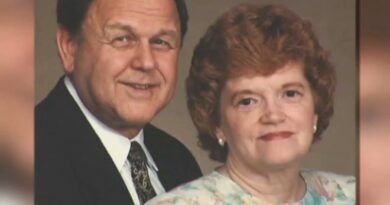Amber Elizabeth Cates Disappeared in Columbia Tennessee
Columbia Tennessee in early spring is a modest town of brick storefronts and quiet neighborhoods that back up to fields and creek beds. Easter decorations linger in windows, the air is mild, and high school students talk about plans for a few days of freedom before finals. On April 11 two thousand four a sixteen year old named Amber Elizabeth Cates had a simple plan. She would leave her mother residence on Tracy Lane, catch a ride with a friend, and spend part of spring break with a relative. It was the kind of plan that countless teenagers make, a plan that assumes tomorrow will look like today. That tomorrow never arrived for Amber. What followed was a vanishing that has occupied her family and her community for more than two decades.
The young woman at the center of the case
Amber was a teenager with the mix of determination and vulnerability that marks that age. She was petite, with blonde hair that she sometimes dyed, green eyes, and a smile that her sister and friends still describe when they speak about her. Teachers and neighbors recalled a young person who was finding her voice, who had hopes that stretched beyond the limits of a small town, and who cared deeply about the people close to her. She was not perfect, as no one is at sixteen, yet she was loved and known. In every account from those who knew her there is the same theme. She did not intend to disappear. She intended to live, to return from spring break, to keep going.
The geography of a few crucial blocks
The home on Tracy Lane sits in a quiet patch of Columbia. Streets curve past one story houses and small yards. The drive from Tracy Lane to the main corridors of town is short. Within minutes a car can reach garages, convenience stores, and two lane roads that lead out toward the countryside. This geography matters because it shapes the window of opportunity that an offender might have had. It is not a place where long drives are required to change a scene. It is a place where a wrong turn onto a side street can hide a car for a while, where a meeting in a driveway can move out of sight in seconds, and where an ordinary transfer from one vehicle to another would not draw a crowd.
The last confirmed movements
On the afternoon of April 11 two thousand four Amber left her mother home with the idea that she would be gone a couple of days. Accounts agree that she got into a gold colored Mazda driven by a male friend. The plan, as it was repeated later by those close to her, was simple. She would spend part of spring break with a relative, check in, and return. She did not have large amounts of money, she did not have a suitcase full of clothes, and she did not leave a note that suggested a long absence. What complicates the picture is what is said to have happened next. The friend reportedly handed her off to another man for a short ride. That second man later stated that he drove her to a garage in Columbia after a quick stop to buy hair dye, then left her there. After that, no one has been able to confirm an independent sighting. No camera caught her face. No clerk remembered a purchase that could be tied to her with certainty. The known trail ends within the borders of her own town.
The first days of searching
When a teenager misses a check in during spring break, some families wait a day to see if plans have shifted. In this case the silence stretched just long enough to breed worry and then resolve. Family members called friends, drove routes that Amber would have known, and stopped at places where she might have been seen. Law enforcement took the report and began the methods that form the backbone of any missing person inquiry. They interviewed the people who saw her last. They looked for time stamped transactions. They canvassed along the short route between Tracy Lane and the garage area where she was said to have been dropped. With each day that passed the chance of finding a simple explanation shrank.
The car that carried her and the idea of movement
The gold Mazda matters not because it belonged to Amber but because it was the vessel of her last confirmed movement. The friend who drove it placed her into the hands of another man. That second driver placed her at a garage. The story of that day depends on the credibility of those two statements and on the physical traces that might have been left in the vehicles or at the stop. In two thousand four it was common to process seats and door pulls for prints and to collect fibers and any visible biological traces. If those items were preserved well, later techniques could still rescue meaning from them. The shape of the car, the route it likely traveled, and the narrow time window between the pickup and the supposed drop off form a puzzle that can be tested against phone records and fuel receipts. Every minute accounted for is a minute narrowed for opportunity.
Theories that have persisted
Over the years several theories have repeated in the community. One suggests that Amber planned only a short visit but fell into the hands of someone who saw a chance to isolate her and did so. Another suggests that she was passed between acquaintances who did not understand the gravity of what was happening until too late and who then told partial truths to shield themselves from blame. A third, darker theory is that she was the victim of opportunistic violence at or near the place where she was last said to be and that those responsible quickly moved her out of sight. There are variations on each idea, but they all turn on the same hinge. Two known drivers, a short urban route, and a sudden break in communication.
The role of the first week in a cold case
The first week sets the tone for the months that follow. In that week investigators either find footage that anchors the timeline or they do not. Witnesses either speak while memories are fresh or they do not. If an item is found that can be tested, it enters the chain of custody early or it risks being lost. In the case of Amber, the first week did not produce a sighting that could anchor the investigation to a single place and time. Without that anchor, every later reexamination has to rebuild the foundation before it can explore new angles. That is not a criticism of anyone who cared or searched. It is an explanation of how fragile the beginnings of a case can be.
Family advocacy and the long work of remembrance
Amber sister and extended family have kept her name present in the years since her disappearance. They have worked with local agencies and with national organizations that amplify missing person cases. Age progressed images were created to show what she might look like as she grew into adulthood. Community events have been held to remind people that a child of Columbia once walked out of a door and did not return. This kind of advocacy matters. It shapes public memory and it keeps pressure on those who may know a small piece and who have not yet found the courage to share it.
Law enforcement posture and federal involvement
From early on the case was treated as endangered missing rather than as a simple runaway. As time passed and no financial activity, no verified sightings, and no communication emerged, that posture hardened. The Maury County Sheriff Office and the city police have had a continuing role. Federal partners took an interest and a reward was offered for information that could lead to recovery or prosecution. The presence of a reward and a federal tip line can flush out people who otherwise would not come forward. It also signals to the community that the case remains open in a real sense, not just as a file on a shelf.
What modern methods could still offer
Time is not always the enemy of a case. If the right items were kept, time can be an ally. Modern DNA techniques can work with trace amounts that would have been considered useless two decades ago. Touch DNA can sometimes reveal profiles from steering wheels, door handles, or seat belt latches. Advanced database searches can compare partial latent prints with a far wider pool than was available at the time. Cell site records, if preserved, can be used with present day mapping tools to create a far finer picture of phone movement on the day in question. Even if no single method delivers an answer, a combination of small insights can break a logjam.
The value of reinterviewing and fresh canvassing
People change. Time softens loyalties. A person who could not speak in two thousand four might be ready in two thousand twenty five. A person who told a partial story might be ready to tell a complete one. For that reason a careful reinterview of everyone who touched the chain of custody of Amber movements that day is valuable. So is a new canvass of the area framed by Tracy Lane, the roads used to reach the garage, and the streets immediately around any place that might match that description. Businesses change hands, but workers often stay in the same trades. Mechanics move from one shop to another. Someone who was present without realizing the significance might now connect a memory with a date because a friend mentioned the case.
Why the case still matters in Columbia
The disappearance of a child, and at sixteen Amber was still a child to those who loved her, does not fade because time passes. It remains a point of unfinished business for a town that prides itself on neighborliness. It challenges the belief that everything important that happens in a place is known by someone. It is a reminder that safety is not only about streetlights and patrol cars, it is also about the moral choices people make when they are the only witness to a small wrong act. When a town keeps speaking a missing person name, it announces that harm will not be quietly accepted and that truth is still expected.
A call to conscience
Some cases are solved by science and some by conscience. This looks like a case that may require both. Someone knows what happened after Amber got into that second car. Someone remembers a stop that was not supposed to be part of the day. Someone heard a story that made them uneasy and then chose to forget it. The invitation today is to do the opposite. Remember. Speak. If you once minimized what you saw because you wanted to believe the best about a friend, allow yourself to reconsider. If you were a young person then and you are a grown person now, you are allowed to change your mind about what loyalty requires. The value of a life outstrips the value of a fragile friendship.
Closing reflection
On an April afternoon a teenager stepped into a car and trusted that she would be back in a few days. Her family set a place for her in their minds and waited. The waiting stretched into weeks and then into years. The facts we can place on a line are simple. She left a home on Tracy Lane in Columbia on April 11 two thousand four. She was passed to another driver for a short ride. She was said to be dropped near a garage in town. After that, nothing we can confirm. The story of Amber Elizabeth Cates is not finished. It is paused at a page that demands a new sentence. The next sentence can come from a lab bench or from a voice that has been quiet too long. When it comes, a family will be given an answer it has earned through endurance, and a town will be able to say that it did not allow this name to fade into the background of its history.
Discover more from City Towner
Subscribe to get the latest posts sent to your email.




